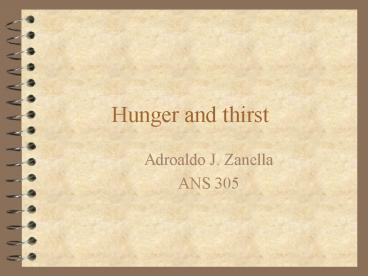Hunger and thirst - PowerPoint PPT Presentation
1 / 26
Title:
Hunger and thirst
Description:
Physiological state of the animal. External factors. Problems I ... Physiological state. Diet. Temperature. Access to water. Water quality. Water=nutrient ... – PowerPoint PPT presentation
Number of Views:517
Avg rating:3.0/5.0
Title: Hunger and thirst
1
Hunger and thirst
- Adroaldo J. Zanella
- ANS 305
2
Introduction
- Freedom from hunger and thirst features as the
first requirement that has to be satisfied in
animal welfare codes/laws in many parts of the
world. - Extreme
- Mild deprivation
3
Background
- Extreme nutrient and water deprivation causes
death. - Failure to satisfy the animals requirement for
essential nutrients leads to illness, poor
performance and death.
4
Background
- Mild deprivation of water and nutrients has
little effect on health and vigor. - Ad libitum feeding of animals may lead to
increase incidence of disease and poor
reproductive performance.
5
Hunger feeding motivation
- The state of the animal in which it is stimulate
to eat - Nutritional properties of the food
- Physiological state of the animal
- External factors
6
Problems I
- Animals need to be hungry or thirsty in order to
eat or drink. - Aristotelian concept of telos
- All animals desire or strive to reach the
functional end for which they were designed.
7
Problems II
- A) Malnourished conditions are limiting by being
inappropriately balanced in relation to the
animals requirements - B) Undernourished conditions are limiting by
being insufficient in relation to the animals
requirements - A B
8
Conditions
- Harsh environments
- Hot temperatures
- Competitive environment
- Lack of feeder and drinker space
- Inadequate drinker feeder design
9
Eating behavior
- Sensory cues
- Nutrients in the diet
- Hormonal factors
10
Feeding strategies
- Decision making processes are often overlooked.
- Pigs are capable of balancing their diets
- Food avoidance is common in many species
- Grazers will not eat in a random fashion.
- Plant chemicals
- Feces
- Nutritional contend
11
Feeding patterns
- Cows may graze from 4-14 h day and bite rates may
vary from 40-80 minute. - Periods of high ingestive intake
- Shortly prior to sunrise
- Mid-morning
- Early afternoon
- Near dusk
12
Feeding patterns
- Horse grazing behavior is affected by
- Early experience
- Quality of the pasture
- Social facilitation
- Temperature
13
Feeding patterns
- Eating behavior in pigs is affected by
- Social hierarchy
- Food quality
- Temperature
- Age
- Genetic background
14
Measurements
- A) Monitor food intake, rate of eating time
spent in food-directed activity. - B) Animals response to operant methodologies
(e.g. the animal needs to work. - C) Trade food acquisition with aversive stimulus.
15
Sources of malnutrition
- Unintentional
- Poorly balanced diets
- Intentional
- Veal calves are sometimes fed on liquid diet
deficient in iron.
16
Sources of undernutrition
- Intentional
- Quantitative restriction
- Sows boars (60)
- Broiler breeders (25)
- Qualitative restriction
- Sows boars
- Ruminants
17
Sources of undernutrition
- Unintentional
- Negative energy balance (poor grazing conditions)
- Restrictions imposed by other group members
- High temperature
- Amount eaten
- Feeding pattern
18
Thirst
- Definition It is a subjective sensation aroused
by lack of water (Rolls Rolls, 1982) - Physiological state
- Diet
- Temperature
- Access to water
- Water quality
19
Waternutrient
- Adjustment of body temperature.
- Maintenance of mineral homeostasis.
- Excretion of end products of digestion anti
nutritional factors. - Achievement of satiety.
- Satisfaction of behavioral drives
20
Secondary drinking
- Hunger induced
- Schedule-induced polydipsia
21
Measurement
- A) Monitor water intake, rate of drinking time
spent in drinking-directed activity. - B) Animals response to operant methodologies
(e.g. the animal needs to work. - C) Trade water acquisition with aversive
stimulus.
22
Water restriction
- Intentional
- Liquid wet feeding (pigs)
- Restricted to periods (broilers pigs)
- Premarin farms
23
Water restriction
- Unintentional
- Blocked pipes
- Inadequate flow rates
- Drinker design
- Water quality
- Social competition
24
Welfare problems
- Sheep will walk more than 25 km (16 miles) a day
foraging - Free range sows will spent over 50 of their time
foraging
25
Welfare problems
- Expression of foraging behavior
- Failure to meet requirements (stress)
- Secondary illness associated with nutrient
(including water) deprivation
26
Behavioral problems
- Abnormal behaviors
- Tail biting
- Wool-stripping
- Redirected behaviors
- Activity levels
- Exploratory behavior
- Food related stereotypies
- Sham-chewing






























